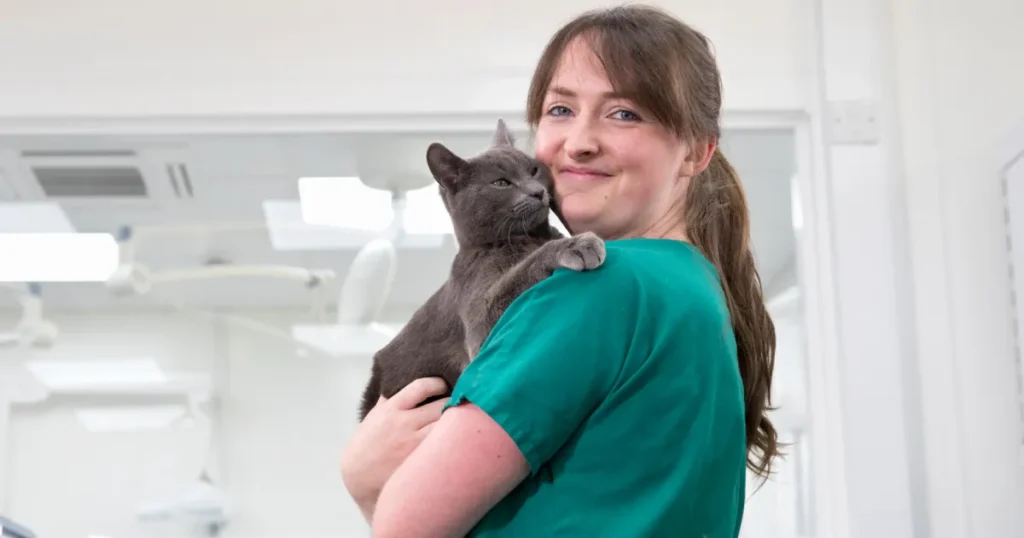The Moment That Changes Everything
It’s 7:15 AM when Maya walks into the veterinary clinic. Before she can even set down her coffee, the phone rings—a panicked owner’s voice on the other end: “My dog ate chocolate. A whole box. Please, is he going to be okay?”
Maya springs into action. Within minutes, she’s prepping the exam room, gathering the activated charcoal, setting up the IV station, and calming the frantic owner as the veterinarian rushes in. By 8 AM, the Labrador is stable, the crisis is managed, and Maya is already moving on to her next patient—a nervous cat needing blood work.
This is the reality of being a veterinary assistant. It’s not just about cuddling puppies (though that definitely happens). It’s about being the steady hands, the calm voice, and the skilled professional who makes animal healthcare possible.
Whether you’re working with anxious dogs, skittish cats, or 1,200-pound horses, veterinary assistants are the backbone of animal care. Let’s dive into what it really takes to care for these amazing creatures.
What Does a Veterinary Assistant Actually Do?
Veterinary assistants provide essential animal care by determining animal requirements, conducting diagnostic procedures, assisting during operations, feeding and caring for animals, maintaining supplies and equipment, and maintaining records.
Think of veterinary assistants as the Swiss Army knives of animal healthcare—versatile, essential, and always ready to jump into action.
Core Responsibilities Include:
- Basic patient care: Feeding, watering, bathing, and exercising animals
- Medical support: Assisting with examinations, surgeries, and diagnostic procedures
- Client communication: Educating pet owners and providing emotional support
- Facility maintenance: Cleaning kennels, sterilizing equipment, and maintaining exam rooms
- Administrative tasks: Scheduling appointments, maintaining medical records, and managing inventory
- Emergency response: Providing first aid and stabilizing animals until a veterinarian can take over
The U.S. Bureau of Labor Statistics reports that veterinary assistants handle routine animal care and help veterinarians and technicians with their daily tasks. Employment in this field is projected to grow 9% from 2024 to 2034—much faster than the average for all occupations—with about 22,200 openings projected each year.
Now, let’s break down the specific skills needed to care for the three most common animals you’ll work with: dogs, cats, and horses.
Caring for Dogs: Man’s Best Friend Needs Expert Hands
Dogs are often the most common patients in veterinary clinics, ranging from tiny Chihuahuas to massive Great Danes. Each brings unique challenges and rewards.
Understanding Canine Behavior and Handling
Dogs communicate through body language, and reading these signals is crucial for safe, effective care. A wagging tail doesn’t always mean a happy dog—context matters.
Key behavioral signs to watch for:
- Fearful: Tucked tail, lowered body posture, ears back, avoiding eye contact
- Aggressive: Stiff body, direct stare, raised hackles, showing teeth
- Stressed: Panting, drooling, yawning, pacing
- Relaxed: Loose body, soft eyes, gentle tail wag
Safe Handling Techniques:
Restraint for Examinations:
Position yourself at the dog’s head, gently but firmly securing the muzzle area with one hand while supporting the body with the other. For larger dogs, you may need to use a standing restraint or assist another team member. Always be prepared for sudden movements—even the friendliest dog can react unpredictably when frightened or in pain.
Muzzling When Necessary:
There’s no shame in muzzling an anxious or aggressive dog. It protects everyone involved—the dog, the staff, and the owner. Use properly fitted basket muzzles when possible, as they allow dogs to pant and breathe comfortably.
Reading the Room:
Some dogs do better on the floor than on an exam table. Others need their owner nearby for comfort. Flexibility and observation are key skills.
Common Canine Procedures You’ll Assist With
Routine Examinations:
You’ll help hold dogs still while veterinarians check ears, teeth, heart rate, and temperature. Your calm demeanor helps keep the dog relaxed.
Vaccinations and Blood Draws:
Restraint is critical here. You’ll need to hold the dog securely while keeping them calm, distracting them with gentle words or treats.
Emergency Care:
Dogs frequently come in for toxic ingestion (chocolate, grapes, xylitol), trauma from accidents, or sudden illnesses like bloat or parvo virus. As a veterinary assistant, you’ll be responsible for triaging patients, placing IV catheters, and performing miscellaneous injections under supervision.
Daily Dog Care Essentials
Feeding:
Follow veterinarian-prescribed diets carefully. Some hospitalized dogs need special nutrition, hand-feeding, or appetite stimulation.
Exercise:
Walking hospitalized dogs provides physical relief and mental stimulation. It also gives you a chance to observe gait, lameness, or behavioral changes to report to the veterinarian.
Hygiene:
Bathing, brushing, and maintaining clean kennels prevents infections and keeps dogs comfortable during recovery.
Monitoring:
Check on hospitalized dogs regularly, watching for signs of distress, pain, or improvement. Document everything meticulously.
Caring for Cats: The Independent Patient
Cats are fascinating creatures with distinct personalities and healthcare needs. They’re often more challenging than dogs because they hide pain and illness remarkably well—survival instinct from their wild ancestors.
Understanding Feline Behavior and Handling
Cats are masters of subtlety. What looks like a calm, relaxed cat can transform into a hissing, scratching ball of fury in seconds if mishandled.
Key behavioral signs:
- Fearful: Flattened ears, dilated pupils, crouched position, hissing
- Aggressive: Swishing tail, direct stare, arched back, growling
- Stressed: Hiding, excessive grooming, refusal to eat
- Content: Slow blinks, purring, kneading, relaxed posture
Safe Handling Techniques:
The “Burrito” Wrap:
For nervous or fractious cats, towel wrapping (also called a “kitty burrito”) is your best friend. Wrap the cat snugly in a towel with only the necessary body part exposed—head for ear checks, paw for blood draws, etc.
Scruffing—Use Sparingly:
While scruffing (gently grasping the loose skin at the back of the neck) can immobilize some cats, modern veterinary practice discourages it unless absolutely necessary. It can increase stress and isn’t always effective.
Create a Calm Environment:
Cats are highly sensitive to noise and smells. Use pheromone sprays, cover kennels with blankets to create “caves,” and minimize loud sounds. Some cats do better examined in their carriers rather than on a cold, slippery table.
Common Feline Procedures You’ll Assist With
Routine Examinations:
Cats require gentle, slow movements. Rushing increases stress, which can elevate heart rate and blood pressure, skewing diagnostic results.
Venipuncture (Blood Draws):
The jugular vein is commonly used for cats. You’ll hold the cat’s head extended while the veterinarian or technician draws blood. Calm, confident restraint is essential.
Urinary Catheterization:
Male cats are prone to urinary blockages—a life-threatening emergency. You’ll assist by restraining the cat in dorsal recumbency (on their back) while the veterinarian places the catheter.
Administering Medications:
Giving pills to cats is an art form. You may need to use pill pockets, compounded flavored medications, or transdermal gels to ensure compliance.
Daily Cat Care Essentials
Feeding:
Cats are notoriously picky eaters. Hospitalized cats often refuse food due to stress, requiring creative solutions like warming food, hand-feeding, or appetite stimulants.
Litter Box Management:
Clean litter boxes are non-negotiable for cats. Monitor litter box usage closely—changes in urination or defecation patterns are often the first signs of illness.
Grooming and Comfort:
Cats groom themselves when stressed or recovering. Provide soft bedding, hiding spots, and minimal handling when not medically necessary.
Monitoring:
Cats hide pain and illness. You need a keen eye to spot subtle changes: Is the cat eating? Grooming? Using the litter box? Any behavioral changes must be documented and reported.
Caring for Horses: When Your Patient Weighs 1,000+ Pounds
Working with horses as a veterinary assistant is a completely different ballgame. These majestic animals require specialized knowledge, physical strength, and nerves of steel.
Understanding Equine Behavior and Handling
Horses are prey animals, which means their instinct is “flight over fight.” They’re also incredibly strong and can injure handlers unintentionally—a frightened horse doesn’t think, it reacts.
Key behavioral signs:
- Fearful: Ears pinned back, wide eyes, snorting, attempting to flee
- Aggressive: Bared teeth, ears flat, kick threats, charging
- Relaxed: Soft eyes, one hind leg rested, ears forward or relaxed
- In Pain: Pawing, sweating, rolling, refusal to eat (especially colic symptoms)
Safe Handling Techniques:
Always Approach from the Side:
Never approach a horse directly from the front or rear. Horses have blind spots directly in front and behind them. Approach from the shoulder, speaking calmly so the horse knows you’re there.
Lead with Confidence:
Use a lead rope attached to the halter, never wrap the rope around your hand (that’s a quick way to lose fingers). Walk beside the horse’s shoulder, not directly in front.
Restraint Methods:
- Twitching: A humane restraint tool that applies pressure to the horse’s upper lip, releasing endorphins and calming the horse during procedures
- Stocks: Sturdy enclosures that limit movement during examinations or treatments
- Chemical Sedation: Often necessary for procedures like dental work or radiographs
Common Equine Procedures You’ll Assist With
Mobile Veterinary Calls:
Many equine veterinarians operate mobile practices, traveling to farms and ranches. As an assistant, you’ll travel along, helping with horse handling, radiographs, ultrasounds, shockwave treatments, and more.
Lameness Evaluations:
You’ll jog horses in straight lines or lunge them in circles while the veterinarian observes gait abnormalities. This requires physical fitness and understanding of proper handling techniques.
Colic Examinations:
Colic (abdominal pain) is a leading cause of death in horses. You’ll assist by restraining the horse during rectal examinations, nasogastric tube placement, and monitoring vital signs.
Dental Procedures (“Floating”):
Horses’ teeth grow continuously and develop sharp points that need filing down. You’ll assist by holding equipment, managing sedation monitoring, and ensuring the horse’s safety during the procedure.
Wound Care:
Horses injure themselves with alarming frequency. You’ll help clean wounds, apply bandages, and monitor healing. Proper bandaging technique is critical—too tight can cut off circulation, too loose won’t protect the wound.
Daily Horse Care Essentials
Feeding and Watering:
Horses need constant access to fresh water and regular feeding schedules. Monitor intake carefully—changes often indicate illness. Hospitalized horses may require special diets or hand feeding.
Stall Maintenance:
Mucking stalls (removing manure and soiled bedding) is physically demanding but essential. Clean stalls prevent hoof infections and respiratory issues.
Exercise:
Some hospitalized horses need hand-walking, grazing, or even riding as part of their recovery. You’ll need basic horsemanship skills and confidence handling large animals.
Grooming:
Regular grooming isn’t just about appearance—it’s health care. You’ll check for wounds, swelling, heat, or abnormalities while brushing, cleaning hooves, and inspecting legs.
Monitoring:
Horses can’t vomit, which makes gastrointestinal issues particularly dangerous. You’ll monitor vital signs, appetite, manure output, and behavior constantly, reporting any changes immediately.
Universal Skills Every Vet Assistant Needs (Regardless of Species)
Whether you’re working with a nervous Chihuahua, a hissing Persian, or a 1,500-pound Thoroughbred, certain skills are non-negotiable:
1. Animal Restraint Mastery
Proper restraint keeps everyone safe—the animal, the staff, and the client. It’s not about force; it’s about technique, confidence, and reading the animal’s body language.
2. Medical Knowledge
Understanding basic anatomy, common diseases, medication administration, and emergency protocols is essential. You need to recognize when a situation is urgent and communicate effectively with veterinarians.
3. Physical Stamina
This job is physically demanding. You’ll be on your feet for 8+ hours, lifting animals (up to 40 pounds frequently, sometimes more with assistance), restraining struggling patients, and performing repetitive tasks.
4. Emotional Resilience
Not every story has a happy ending. You’ll witness euthanasia, comfort grieving owners, and sometimes lose patients despite your best efforts. Developing healthy coping mechanisms is crucial for long-term success in this field.
5. Communication Excellence
You’ll communicate with veterinarians, technicians, fellow assistants, and pet owners daily. Clear, compassionate communication prevents mistakes, builds trust, and ensures quality patient care.
6. Attention to Detail
Documenting treatments, monitoring vitals, maintaining medical records, and following protocols require meticulous attention. A missed detail can have serious consequences.
7. Teamwork
Veterinary medicine is a team sport. You’ll work alongside veterinarians, licensed veterinary technicians, receptionists, and other assistants. Anticipating needs, supporting teammates, and accepting feedback are essential skills.
The Reality Check: Challenges and Rewards
The Challenges
Physically Demanding:
Long hours on hard floors, heavy lifting, exposure to bites, scratches, and kicks. This job will test your body.
Emotionally Taxing:
Dealing with animal suffering, euthanasia, and distraught owners takes a toll. Self-care isn’t optional—it’s mandatory.
Exposure to Hazards:
Zoonotic diseases, radiation (X-rays), anesthesia gases, and aggressive animals are occupational hazards. Strict safety protocols protect you, but risks exist.
Variable Schedule:
Many clinics operate evenings, weekends, and holidays. Emergency clinics require night shifts. Flexibility is essential.
The Rewards
Making a Real Difference:
Every day, you’re alleviating suffering, saving lives, and reuniting healthy pets with relieved owners. That’s powerful.
Continuous Learning:
No two days are identical. You’ll encounter new cases, learn new skills, and constantly grow professionally.
Animal Connection:
If you love animals, this job lets you work with them daily in meaningful ways—not just petting them, but truly caring for their health and well-being.
Career Stability:
With 9% projected job growth through 2034, veterinary assistant positions are in demand. Pet ownership continues to rise, and people increasingly view pets as family members deserving quality healthcare.
Pathway to Advancement:
Many veterinary assistants use this role as a stepping stone to becoming licensed veterinary technicians, veterinarians, or specialists in areas like anesthesia or emergency medicine.
Getting Started: Your Path to Becoming a Veterinary Assistant
Most veterinary assistant positions require at least a high school diploma. While formal training isn’t always mandatory, completing a veterinary assistant program significantly improves your job prospects, earning potential, and confidence in the role.
What You’ll Learn in a Quality Program:
- Animal anatomy and physiology: Understanding how bodies work across species
- Veterinary medical terminology: Speaking the language of animal healthcare
- Handling and restraint techniques: Species-specific methods for safe care
- Basic clinical procedures: Assisting with exams, surgeries, and diagnostics
- Pharmacy and medication administration: Understanding drugs and proper dosing
- Laboratory skills: Preparing samples, running tests, interpreting results
- Nursing care: Post-operative monitoring, wound care, patient comfort
- Office procedures: Scheduling, record-keeping, client communication
- Safety and sanitation: Infection control, equipment sterilization, hazard management
Hands-On Experience Matters:
Look for programs that include practicum placements where you’ll work in real veterinary settings. This practical experience is invaluable—it’s where classroom knowledge becomes muscle memory.
The Bottom Line: Is Veterinary Assisting Right for You?
Being a veterinary assistant isn’t for everyone. It requires physical strength, emotional resilience, scientific curiosity, and genuine compassion for animals and their humans.
But if you’re the type of person who:
- Lights up around animals of all sizes
- Stays calm in emergencies
- Loves learning and problem-solving
- Wants to make a tangible difference every single day
- Doesn’t mind getting a little dirty (or a lot)
…then veterinary assisting might be your calling.
The median annual wage for veterinary assistants was $37,320 in May 2024, according to the Bureau of Labor Statistics. While it’s not a path to wealth, it’s a career rich in purpose, variety, and the kind of moments that make you remember why you started.
Like that moment when the chocolate-eating Labrador goes home healthy, tail wagging, owner crying tears of relief. That’s when Maya knows: all the hard work, the early mornings, the emotional challenges—it’s all worth it
FAQs
-
Do I need a college degree to become a veterinary assistant?
Most positions require at least a high school diploma, though formal training through a veterinary assistant program significantly improves your job prospects and preparedness.
-
What’s the difference between a veterinary assistant and a veterinary technician?
Veterinary technicians are licensed professionals (like nurses) who can perform more advanced medical procedures. Assistants support both veterinarians and technicians with basic care tasks.
-
Can veterinary assistants work with exotic animals?
Yes! Some clinics specialize in exotic pets (birds, reptiles, small mammals) or wildlife. Additional training in exotic animal handling is beneficial.
-
Is being a veterinary assistant emotionally difficult?
Yes. You’ll witness euthanasia and animal suffering. Developing healthy coping strategies and having a supportive workplace are crucial for emotional wellbeing in this field.
-
Where can I get hands-on training to become a veterinary assistant?
Granville College offers a Veterinary Technician Assistant Diploma (24 weeks) in Vancouver and Surrey. Our program combines classroom instruction with real-world practicum experience, preparing you to work with dogs, cats, and other animals in clinics across BC. Learn animal handling, clinical procedures, and the practical skills veterinary facilities need. Visit www.granvillecollege.ca to explore this rewarding career path.





